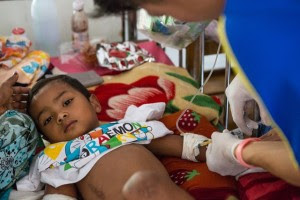From out of Mae Tao Clinic’s Child Outpatient Department the sound of crying babies can be heard. A queue of parents, children in tow, wait outside the basic concrete building for their children to be weighed, measured and checked for serious diseases.
 “We have six medics and four community health workers to cope with the children.” Dixie, a medic from Child OPD gestures around the dimly lit room to the nervous line of patients.
“We have six medics and four community health workers to cope with the children.” Dixie, a medic from Child OPD gestures around the dimly lit room to the nervous line of patients.
Dixie has been a medic at MTC for 15 years. A refugee, she fled the Burma’s former military regime’s crackdown against pro-democracy activists in 1988 and says she always wanted to work in primary health care. “It was always my dream to be a medic.”
Dixie takes a child’s temperature. The child, three and a half year old Chit Htoo, his mother, Mee Myint Win, 26, says the boy has been sick with fever for three days.
Dixie says the child’s fever will go away, but that Chit Htoo’s heart beat is abnormal. “He has come back as underweight so it could be possible anemia or a low hemoglobin count caused by malnutrition or possibly a serious congenital problem,” she says, her eyes not leaving Chit Htoo, “we will have to do some tests to find out what the problem is.”
Mee Myint Win says she traveled with her sick son to Mae Tao Clinic from Pago division, Burma, because she could not afford healthcare in her hometown.
“I was worried about my son, I cannot afford the check up in Burma, it is more than 10,000 Kyat just for some basic tests,” she says grasping her sons hand.
Mae Tao Clinic, based on the Thai side of the Thailand’s border with Burma, treats around 150,000 people per year. Around half of the patients come from Burma. The clinic treats a vast range of diseases and injuries, ranging from malaria and heart disease, to landmine victims.
In 2013, UNICEF noted in a report that healthcare received a mere 5.7% of total government spending in Burma. As a percentage of GDP this amounts to 0.76%. In contrast, during 2012-2013, about 29% of Burma’s budget went to the defense forces, according to a budget overview by UNICEF.
Dixie said that she had seen little difference in the numbers of patients or diseases presented at the Clinic since Burma’s 2011 elections.
“We still see [coming to the Clinic] malnutrition rates of around 50 children a day, I mean children under 12 months. Perhaps 15 of those children will have serious health complications because of malnutrition.”
A child comes into the room, her breathing harsh and loud. Dixie rushes over to supervise treatment.
Children with the most serious diseases and injuries go to the pediatric ward.
“On any given day we are seeing cases of serious burns, pneumonia, paramecia, nephritic syndrome, Kidney problems, severe malnutrition and respiratory complications,” explains Pan Aye, 36, a pediatrician, her face covered by a mask.
Unlike the loud bustle of OPD, the small patients in pediatrics lie silent.
“Of the two dozen most serious cases we get every day, around half are from severe malnutrition,” Pan Aye estimates that as many as 75% of her patients are from Burma.
Pan Aye is angry with Burma’s government for refusing to recognise community-based organisations, like MTC.
“Burma’s healthcare system is very bad. The government doesn’t even recognise us health workers at Mae Tao Clinic.”
Mae Tao Clinic’s latest report noted that total admissions rose almost 17% between 2011 and 2012, with 50% of admitted patients coming from Burma.
The report notes that the rise in cases, despite Burma’s political reforms, the reality is that “basic public health interventions to prevent sickness for the most vulnerable members of society, such as infants and mothers, remains distant. These are not realities that will change overnight and despite the political changes in Burma unfolding in 2012, it will be many years before the people of Burma will be able to equitably access quality, affordable health care,” the report said.
Ah Moe, a migrant worker from Burma, lives in Thailand with her four children and husband. She works as a carpenter while her husband is a plantation worker. She came to MTC with her three year-old son, Thao Zao Win, his limbs are covered in bandages. “Me and my husband were out working and he badly burned himself at home,” Ah Moe says, “It is very difficult living in Thailand as a migrant worker with a family to feed. We can’t look after our children because we have to both go and work whenever we can to live.”
Ah Moe said finding work and accommodation close to schools is difficult.
“We live too far away from any migrant schools and there is no available transportation, so I have to leave the children at home all day.” Even though they both work, they do not earn enough to save money. “It is impossible to save any money here in Thailand, the cost of living is too high for us.”
A medic walks over to the bed and injects Thao Zao Win – he stares intently at the ceiling.
This is not the first time Ah Moe faced tragedy, her oldest son drowned in a river last year when the children were all playing while she was at work.
“I still miss him so much,” Ah Moe says, tiredly stroking Thao Zao Win’s head.
“My dream is for my children to have an education. I don’t want my children to be like me,” Ah Moe says.



